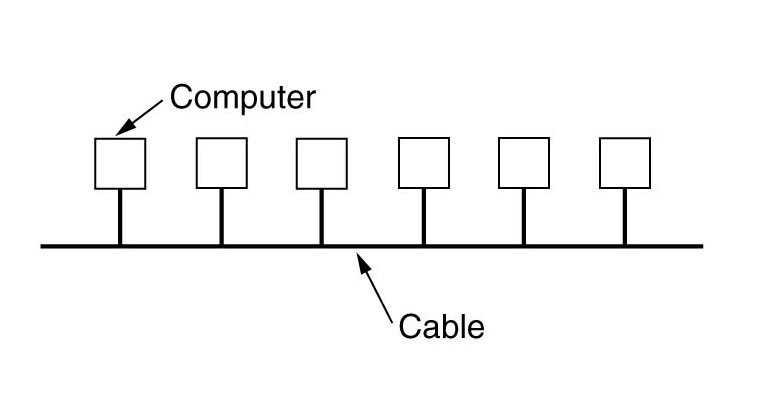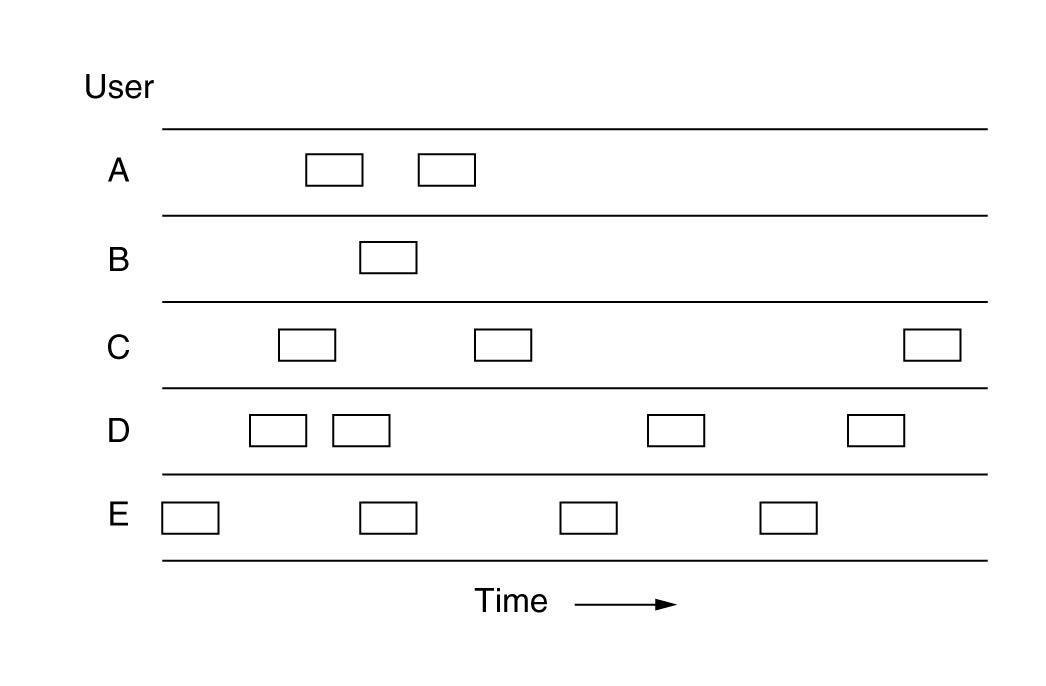Broadcast networks
Recall
1.2.
LAN
- single building, campus, single company
Limited size network.
Worst-case transmission time is bounded and known in advance.
This makes possible certain designs - e.g. setting of tight
timeouts.
High speed - up to 10 G bps
Low errors
Ethernet
Ethernet model
dominates LANs
(though new competition from
wireless LANs).
Ethernet is broadcast network.
"Bus" network (all machines attached to one cable):

Search for
other images.
Best image here.
Router leads to Internet.
1.5.3 Arbitration mechanism
Only 1 node can transmit at a time. All others have to refrain.
Constant conflicts. Need arbitration mechanism
to decide who gets to transmit for next short time interval.
Ethernet algorithm:
Listen first. If someone transmitting, wait.
When transmission over, you transmit (but so will others who have been waiting).
If collision, back off - in fact, jam the ether to alert all nodes.
The other nodes will back off too.
You wait short random time, try again.
If still collision, you double the random wait time, and so on.
Crucial point: If everyone backed off and waited the same
amount of time
and then tried again, what would happen?
Ch.4 Medium Access Control
Physical / Data Link layer for a
broadcast medium
such as a LAN.
4.1.1 Static Channel Allocation
Frequency Division Multiplexing
- Each user gets a private frequency band. No interference.
If no. of users is small and
constant,
each with a heavy load (
always stuff to send),
this works (e.g. between telephone switching offices).
If no. of users is large, constantly varying,
or traffic is very bursty, FDM wastes bandwidth.
e.g. on a LAN this doesn't work so well.
Computer traffic is very bursty
(peak traffic to mean traffic ratios of 1000:1 are common).
So most channels will be idle most of the time.
Also new users denied a channel because all n channels allocated,
even if many idle.
True also with
Time Division Multiplexing
if time slots static, reserved in advance.
If time slots dynamic, though, we can use more bandwidth.
4.1.2 Dynamic Channel Allocation
Dynamic frequency slots
- Used on
fiber
LANs.
See 4.2.5.
Dynamic time slots
- ALOHA and Ethernet.
4.2.1 ALOHA
- Aloha,
ancestor of Ethernet.

Pure ALOHA: Frames transmitted at arbitrary times.
If any bit of a frame overlaps with any bit of another:
collision, both frames are lost and must be re-transmitted.
How can we best avoid collisions?
Slotted ALOHA
Divide time into intervals. Each length of 1 frame.
Nodes have to send at start of a timeslot.
Much reduces collisions and increases throughput.
Aloha led to Ethernet.
Aloha discarded.
Recently, has got new lease of life with
Internet on cable TV.
4.3 Ethernet
Ethernet:
Check if medium busy before trying to send.
Much reduces collisions and increases throughput.
This is called
Carrier Sense.
This is possible on cable LAN, but not on wireless LAN.

Ethernet cabling.

"Fast Ethernet" cabling.

"Gigabit Ethernet" cabling.
Note Ethernet not all fiber.
Copper wires still used for high-speed Ethernet (but only over short distance).
4.3.3 Ethernet Medium Access / Data Link protocol
Each frame starts with preamble of 8 bytes
- each 10101010.
Helps synchronize sender and receiver bit boundaries.
Frame has addresses, since this is not point-to-point.
Data variable size up to max 1500 bytes.
Not allowing frames below a minimum size
is found useful in collision detection.
So if very little data,
the frame is padded up to minimum length.
CRC checksum.
Data Link layer is unreliable, connectionless,
datagram service
(like
PPP and IP).
For reliable, connection-oriented service:
acks (an ack frame)
and re-transmits in higher level
(like
TCP).
Ethernet on copper:
- Analog cable. Change in voltage.
- Ethernet doesn't use 0 volts for a 0 bit
and x volts for a 1 bit
because can't tell difference between a transmit of 0 and an idle sender.
Uses -x volts and +x volts (x=0.85 on Ethernet).
- Ethernet uses
Manchester Encoding
(not differential)
to synchronise bit boundaries.

Frame formats on (a) old Ethernet, (b) IEEE 802.3.
4.3.4 Binary Exponential Backoff Algorithm
- After 1st collision, each node ("station")
waits either 0 or 1 slots
before trying again.
If two pick the same random number, there is a 2nd collision.
- After 2nd collision, each waits 0, 1, 2 or 3 slots at random.
- If 3rd collision, each waits 0 .. 7 slots.
- ...
- After n'th collision, each waits random 0 .. 2n-1 slots
After certain max. no. of collisions, we give up.
Network failure reported.
This algorithms adapts
as the number of stations trying to send
grows and shrinks.
Consider:
-
If constant:
"After any collision, wait random 0 .. 1023"
Then with 2 stations would almost never get a second collision.
But would introduce huge delays.
On the other hand, if hundreds of stations trying to send,
such a rule would make sense,
and would not waste time.
There may be hundreds of stations online,
but the number trying to send
at any time
varies widely.
-
If constant:
"After any collision, wait random 0 or 1"
Consider if 100 stations trying to send.
They will collide again and again until 99 of them pick 1
and one picks 0.
This could take years.
Dynamic rule:
Low delay when only a few stations collide.
Longer delay (can't help that)
when lots of stations collide, but collision is resolved.
Privacy on a broadcast LAN
- Packet sniffing
- To stop sniffing:
- Detect sniffing
- On wireless, Wi-Fi encryption
- On wired (and wireless), encrypted communication in major protocols:
- command-line:
ssh
- file transfer:
sftp
- web browsing:
https
- email:
SSL/TLS connection





